 |
 |
Universe Timeline
back to History of the Universe
 |
|
The Big Bang
0.000000000000000000000000000000000001 seconds after the Big
Bang
The universe began with a vast explosion that generated space and time, and
created all the matter and energy in the universe. Exactly what triggered this
sudden expansion remains a mystery. Astronomers believe it involved a runaway
process called "inflation," in which a peculiar type of energy that existed in
the vacuum of space was suddenly mobilized. The inflationary expansion ended
only when this energy was transformed into more familiar forms of matter and
energy. |
 |
|
Ultimate High-Energy Lab
1 second after the big bang
After inflation ended in the first tiny fraction of a second, the universe
continued to expand but not nearly so quickly. As the universe cooled, the most
basic forces in nature emerged: first gravity, then the strong force, which
holds nuclei of atoms together, followed by the weak and electromagnetic
forces. In its first second of existence, the universe was made up of
fundamental particles, including quarks, electrons, photons, and neutrinos.
Protons and neutrons then began to form. |
 |
|
Basic Elements Form
3 minutes after the big bang
In the next few minutes, the universe as we know it took shape. Already
incomprehensibly large, its protons and neutrons came together to form the
nuclei of simple elements. That the universe remains largely made up of these
elements—hydrogen and helium—is considered strong evidence of the
validity of the big bang model. |
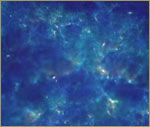 |
|
From Hot to Cold
500,000 years after the big bang
For the next 300,000 to 500,000 years or so, the universe remained an enormous
cloud of hot expanding gas. When this gas had cooled to a critical threshold,
electrons were able to combine with hydrogen and helium nuclei. Photons no
longer scattered, but rushed outward. We can still see the photons emitted from
this period, but time and distance have shifted them into microwave
wavelengths. Today, this cosmic microwave background radiation gives
astronomers a window onto the early universe. |
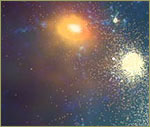 |
|
Birth of Stars and Galaxies
1,000,000,000 years after the big bang
As time moved forward, the pull of gravity exerted its influence on the early
universe. It amplified slight irregularities in the density of the primordial
gas. Even as the universe as a whole continued to expand, pockets of gas became
more and more dense. Stars ignited within these pockets. Groups of stars then
became the earliest galaxies. Modern telescopes can detect these primordial
galaxies as they appeared when the universe was only one billion years old, just 7 percent of its present age. |
 |
|
The Era of Quasars
3,000,000,000 years after the big bang
From one billion to three billion years after the big bang many smaller
galaxies merged into larger ones, forming an array of shapes resembling spirals
and spheres (known as elliptical galaxies). Often the merger was so violent
that stars and gas collapsed into a common center, becoming so dense they
formed gigantic black holes. The gas flowing into these black holes became hot
enough to glow brightly before it disappeared. The light of these "quasars" can
be seen across the depths of the universe. |
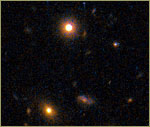 |
|
Supernova 9933
6,000,000,000 years after the big bang
Within galaxies, as stars were being born, others died...often in enormous
cataclysmic explosions. These explosions, called supernovae, are important to
the evolution of galaxies because they distribute all the common elements such
as oxygen, carbon, nitrogen, calcium, and iron into interstellar space.
Explosions of especially massive stars also create and distribute heavier
elements such as gold, silver, lead, and uranium. The supernova pictured here
is of a smaller type, used by astronomers to determine distance. This one
appears to us now as it looked when the universe was about five billion years
old. |
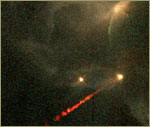 |
|
Birth of the Sun
5,000,000,000 years before the present
The sun formed within a cloud of gas in a spiral arm of the Milky Way galaxy. A
vast disk of gas and debris that swirled around this new star coalesced into
planets, moons, and asteroids.
The image on the left, from the Hubble Space Telescope, shows a star in the
throes of birth. Powerful jets of radiation roar out of its poles, lighting up
the surrounding environment. |
 |
|
Galaxies Collide
3,000,000,000 years in the future
Astronomers estimate that in about three billion years, our Milky Way galaxy
will be swallowed up by one of its nearest neighbors, a large galaxy named
Andromeda that lies 2.2 million light-years away. Depending on their pathways,
these two galaxies will either merge into a single gigantic galaxy or rip each
other apart, sending millions of stars like our sun hurling into space. One
such titanic collision involving four galaxies, 300 million light-years away,
is pictured at left. |
 |
|
Galaxies Disappear
100,000,000,000 years in the future
If recent observations of cosmic acceleration are
correct, then the "vacuum energy" that is emerging in the universe will
continue to overtake the pull of gravity from matter. This means that, in the
future, gravitationally bound clusters of galaxies will survive but galaxies in
general will fly ever more rapidly apart. Eventually our nearest unbound
neighbors will be so far away that they will no longer be seen, even with big
telescopes. But this will be so far in the future that our sun will have long
since burned out and our Earth died with it. |
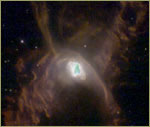 |
|
Stellar Era Ends
1,000,000,000,000 years in the future
During this era, which will last from 100 billion years to one trillion years
after the big bang (and is the era we are currently in), most of the energy
generated by the universe will be in the form of stars burning hydrogen and
other elements in their cores. This long period will give way to an even
longer, lingering death for our universe. |
 |
|
The Degenerate Era
10,000,000,000,000,000,000,000,000,
000,000,000,000 years in the future
This era extends to ten trillion trillion trillion years after the big bang.
Most of the mass that we can currently see in the universe will be contained in
stars that have blown up and collapsed into black holes and neutron stars. Or
it will be locked up in brown dwarfs and planets that never triggered nuclear
fusion, or in stars that withered into white dwarfs. With stars no longer
actively burning, energy in this era is generated through proton decay and
particle annihilation. |
 |
|
The Black Hole Era
10,000,000,000,000,000,000,000,000,000,
000,000,000,000,000,000,000,000,000,000,
000,000,000,000,000,000,000,000,000,000,
000,000,000,000 years in the future
This era extends to ten thousand trillion trillion trillion trillion trillion
trillion trillion trillion years after the big bang. After the epoch of proton
decay, the only star-like objects remaining are black holes of widely varying
masses. Their energy is steadily evaporating. |
 |
|
The Dark Era
>10,000,000,000,000,000,000,000,000,000,
000,000,000,000,000,000,000,000,000,000,
000,000,000,000,000,000,000,000,000,000,
000,000,000,000 years in the future
At this late stage, protons will have decayed and black holes will have almost
completely evaporated. Only the byproducts of these processes remain: mostly
neutrinos, electrons, positrons, and photons of enormous wavelengths. For all
intents and purposes, the universe as we know it will have come to an end. |
Images: (1-5) From a simulation of the Formation of Galaxies and Large Scale
Structure by Michael Norman, Brian O'Shea and Greg Bryan, Grand Challenge
Cosmology Consortium (GC3), and visualized by Donna Cox, Stuart Levy, Robert
Patterson, NCSA/UIUC; (6,8,9,11) STScI/AURA/NASA; (7) High Z; (10,12) NOVA/NASA.
History of the Universe |
Birth of a Supernova |
Tour the Universe
Moving Targets |
How Big is the Universe? |
Spin a Spiral Galaxy
Resources |
Transcript |
Site Map |
Runaway Universe Home
Editor's Picks |
Previous Sites |
Join Us/E-mail |
TV/Web Schedule
About NOVA |
Teachers |
Site Map |
Shop |
Jobs |
Search |
To print
PBS Online |
NOVA Online |
WGBH
© | Updated November 2000
|
|
|